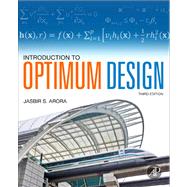Introduction to Optimum Design

Introduction to Optimum Design
- ISBN 13:
9780123813756
- ISBN 10:
0123813751
- Edition: 3rd
- Format: Hardcover
- Copyright: 08/17/2011
- Publisher: Elsevier Science
Rent
Sorry, this item is currently unavailable on Knetbooks.com
Note: Supplemental materials are not guaranteed with Rental or Used book purchases.
Extend or Purchase Your Rental at Any Time
Need to keep your rental past your due date? At any time before your due date you can extend or purchase your rental through your account.
Summary
Introduction to Optimum Design is the most widely used textbook in engineering optimization and optimum design courses.#xA0;It is#xA0;intended for use in a first course on engineering design and optimization at the undergraduate or graduate level within engineering departments of all disciplines, but primarily within mechanical, aerospace and civil engineering. The basic approach of the text is to describe an organized approach to engineering design optimization in a rigorous yet simplified manner, illustrate various concepts and procedures with simple examples, and demonstrate their applicability to engineering design problems. Formulation of a design problem as an optimization problem is emphasized and illustrated throughout the text. Excel and MATLAB are featured throughout as learning and teaching aids. The 3rd edition has been reorganized and enhanced with new material, making the book even more appealing to instructors regardless of the level they teach the course. Examples include moving the introductory chapter on Excel and MATLAB closer to the front of the book and adding an early chapter on practical design examples for the more introductory course, and including a final chapter on advanced topics for the purely graduate level course. FEATURE: Basic concepts of optimality conditions and numerical methods are described with simple and practical examples Benefit: Providing numerous examples helps stimulate students' interest in and ability to learn the material. FEATURE: Formulation of a problem as an optimization problem is emphasized throughout the text. Benefit: The ability to optimally solve an engineering problem for a desired goal depends in large part on how clearly the problem is formulated. If the formulation of the problem is correct, the solution will be useful. FEATURE: Methods for linear and nonlinear programming are presented and illustrated. Benefit: As both linear and nonlinear problems are encountered in actual engineering practice, students are exposed to some of the methods they can expect to use in their professional lives. FEATURE: Applications of the methods for structural, mechanical, aerospace, industrial and biomedical engineering problems are presented. Benefit: Students are introduced to real-world applications where optimization methods are used in a variety of engineering disciplines. FEATURE: Excel is used throughout to solve and interpret solutions of optimization problems. Benefit: Excel is inexpensive and widely available, and is easy to use for solving optimization problems.








